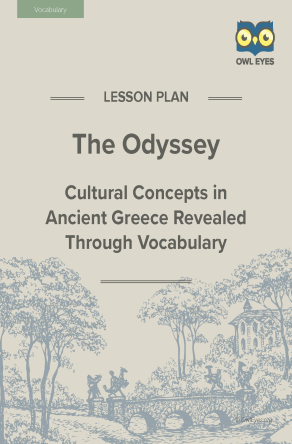The Odyssey Vocabulary Lesson Plan
- 23 pages
- Subject: Historical Context, Themes, Vocabulary, Lesson Plans and Educational Resources
- Common Core Standards: RL.9-10.1, RL.9-10.2, RL.9-10.4, RL.9-10.6
- Grade Levels: 9, 10, 11
Additional The Odyssey Resources
Product Description
Cultural Concepts in Ancient Greece Revealed Through Vocabulary in the Odyssey
This lesson plan focuses on analyzing passages from Book IV of the Odyssey and interpreting how they reflect the culture of ancient Greece. Students will identify and explain examples of words and phrases that illustrate the concepts of oikos, xenia, and kleos. By analyzing Homer’s diction in relation to Greek culture, students will be better able to identify and expound upon themes in the Odyssey.
Skills: vocabulary building, close reading, drawing inferences from the text
Learning Objectives: By the end of this lesson, students will be able to
- identify and describe Odysseus and members of his family and summarize the plot of the poem
- define oikos, xenia, and kleos and explain what these concepts reveal about ancient Greek culture
- locate words and phrases in the text that illustrate oikos, xenia, and kleos and describe how the vocabulary relates to the cultural concepts and the characters’ actions
- describe themes in the poem suggested by vocabulary in the text
- approach the Odyssey and other ancient Greek texts with more familiarity and ease
About This Document
Owl Eyes lesson plans have been developed to meet the demanding needs of today’s educational environment and bridge the gap between online learning and in-class instruction. The main components of each plan include the following:
- An introduction to the text
- A step-by-step guide to lesson procedure
- Previous and following lesson synopses for preparation and extension ideas
- A collection of handouts and worksheets complete with answer keys
Each of these comprehensive, 60-minute plans focus on promoting meaningful interaction, analytical skills, and student-centered activities, drawing from the Common Core Standards for English Language Arts and the expertise of classroom teachers.
Introduction to the Lesson
Written at the end of the 8th century BCE, Homer’s Odyssey is one of the foundational texts of Western literature.
It tells the story of Odysseus, a Greek hero of the Trojan War, as he attempts to return home to Ithaca after the fall of Troy. It takes Odysseus ten years to return home because his pride leads him to insult the god Poseidon, who then punishes Odysseus, sabotaging his journey by creating great perils for Odysseus to overcome. Odysseus uses his cunning, intelligence, and strength to battle a cyclops, outsmart sirens, and venture into the underworld; once at home, he employs the same heroic qualities to defeat a hundred suitors who have descended on his wife and taken over his house in his absence. He is aided by the goddess Athena and great kings along the way. While at the beginning of the story Odysseus’s hubris, or excessive pride, almost destroys him, by the end of his epic journey, he has demonstrated the fine qualities of character that establish him as the epitome of a Greek hero.
Many aspects of the Odyssey reflect ancient Greek culture, which can be hard for modern readers to comprehend. Concepts such as the Greeks’ allegiance to one’s heritage and family lineage, the position of women in society, and the rights of guests in one’s home have largely faded from Western culture. However, by examining passages in the Odyssey, readers can more easily understand the culture of ancient Greece and the themes in Homer’s epic poem.
Worksheet Excerpt: Analyzing a Passage in Book IV Passage 1
Working with the members of your group, complete the steps in Part I and Part II of the activity for your excerpted passage.
Part I:
- Discuss the setting, circumstances, and events in your assigned passage.
- Determine which of the three Greek concepts (oikos, xenia, or kleos) the passage most clearly illustrates.
- Choose three words from the passage that suggest the concept.
- Discuss how the three words help illustrate the Greek concept that you identified in the passage.
Part II:
- Continuing to work together, complete the activity chart.*
- Choose one member of your group to highlight the passage in the text and write an annotation summarizing how the passage illustrates oikos, xenia, or kleos.
- Discuss the annotation as it is being written to make sure it thoroughly reflects the conclusions of your group.







